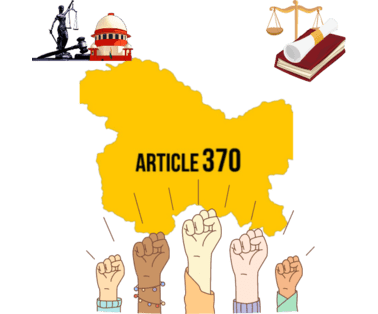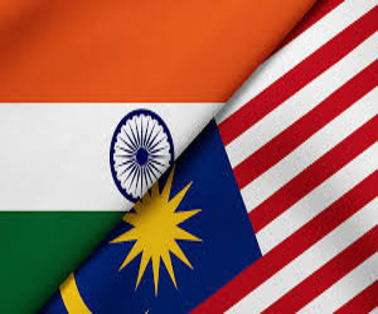The Supreme Court of India began hearing the constitutional challenge to the 2019 abrogation of Article 370 of the Constitution which granted special status to Jammu and Kashmir.
Key Points About Article 370 Constitution
- The petitioners challenging the decision have argued that Article 370 was not a “temporary provision” as it was often called, but a permanent feature of the Constitution that reflected the unique circumstances of the state’s accession to India.
- The President of India promulgated the Constitution (Application to Jammu and Kashmir) Order, 2019.
- The order effectively abrogates the special status accorded to Jammu and Kashmir under the provision of Article 370– whereby provisions of the Constitution which were applicable to other states were not applicable to Jammu and Kashmir (J&K).
- According to the Order, provisions of the Indian Constitution are now applicable in the State.
What Is Article 370 Constitution?
- Article 370 was the basis of Jammu and Kashmir’s accession to the Indian union at a time when erstwhile princely states had the choice to join either India or Pakistan after their independence from the British rule in 1947.
- The provision was incorporated in Part XXI of the Constitution: Temporary, Transitional and Special Provisions.
- It allows the Indian-administered region jurisdiction to make its own laws in all matters except finance, defence, foreign affairs and communications.
- It established a separate constitution and a separate flag and denied property rights in the region to the outsiders.
- That means the residents of the state live under different laws from the rest of the country in matters such as property ownership and citizenship
History of Article 370 in the Indian Constitution
- Under the Indian Independence Act, all princely states were offered the choice to either be an independent country or to join the dominion of India or Pakistan. This was to be done through an Instrument of Accession (IoA).
- The then king of the princely state of Kashmir, Raja Hari Singh, initially decided to remain independent.
- However, following the invasion of Pakistan-backed forces in Oct 1947, Raja Hari Singh sought India’s help which in turn sought the accession of Kashmir to India was a precondition for support.
- The IoA was subsequently signed with the parliament only having powers over J&K to legislate with respect to matters concerning defence, communications and external affairs.
What is Article 35A?
- Article 35A was introduced through a presidential order in 1954 to continue the old provisions of the territory regulations under Article 370 of the Indian constitution.
- The article permits the local legislature in Indian-administered Kashmir to define permanent residents of the region.
- It forbids outsiders from permanently settling, buying land, holding local government jobs or winning education scholarships in the region.
- The article, referred to as the Permanent Residents Law, also bars female residents of Jammu and Kashmir from property rights in the event that they marry a person from outside the state. The provision also extends to such women’s children.
Developments and Initiatives Post-2019 Abrogation of Article 370
- The government has launched various development projects in J&K, such as road and rail connectivity, health and education infrastructure, tourism and heritage promotion, sports and youth empowerment, etc.
- The government has also implemented various flagship schemes of the central government in J&K, such as Ayushman Bharat, Ujjwala Yojana, PM Kisan Samman Nidhi, PM Awas Yojana, etc.
- To showcase the potential of J&K as a destination for tourism and investment, the government hosted theG20 Tourism Working Group meeting in Srinagar.
- In June 2022, the government also held a Global Investors Summit in J&K, which witnessed participation from more than 200 domestic and foreign companies.
- The government has conducted the first-ever district development council (DDC) elections in J&K in December 2020, which saw a high voter turnout of 51.42%.
- The government has also amended the Jammu and Kashmir Panchayati Raj Act, 1989 to provide for reservation of seats for women, scheduled castes, scheduled tribes, and backward classes in panchayats.
- The security forces have eliminated more than 800 terrorists and arrested over 5,000 over ground workers of terrorist outfits in the last four years.
Developments in the UT of Ladakh:
- The government has accelerated the work on infrastructure projects like: The Zojila tunnel, which will provide all-weather connectivity between Srinagar and Leh.
- The Leh airport expansion
- The government has also improved the telecommunication network in Ladakh by laying fibre-optic cables and installing solar-powered towers
- Providing employment-oriented skill development training to more than 75,000 youths of Ladakh.
- Setting up two new AIIMS-like institutes in Leh and Kargil.
- Launching a health insurance scheme for all residents of Ladakh under Ayushman Bharat Pradhan Mantri Jan Arogya Yojana (AB-PMJAY).
- Constituting a Hill Council for Kargil district to ensure local representation and autonomy.
To Download Monthly Current Affairs PDF Click here
Click here to get a free demo
Everything About CLAT 2026
Frequently Asked Questions
Article 370 if the Indian constitution is related:
Article 370 if the Indian constitution is related to Jammu & Kashmir
Who has been appointed as the first Lt Governor of Ladakh
R K Mathur has been appointed as the first Lt Governor of Ladakh
Article 370 which gives special status to Jammu & Kashmir exist in the Indian constitution because of the agreement between Jawahar Lal Nehru and Maharaja Hari Singh
What was the purpose of Article 370?
The purpose of Article 370 is to
- To provide autonomy to Jammu and Kashmir
- To allow Jammu and Kashmir to have its own constitution, flag, and anthem
- To give special rights to the permanent residents of Jammu and Kashmi
What are the rights of the citizens of the new union territory of Jammu and Kashmir?
The citizens of the new union territory of Jammu and Kashmir have all the Fundamental Rights guaranteed by the Indian constitution



